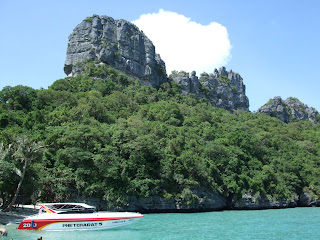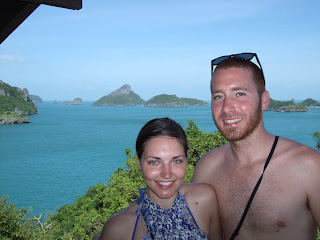A few weeks ago my friend Sarah and I ran a 20k trail course through Kyoto's mountains. When we decided to do the event months ago we thought we'd be running in the Kyoto City Marathon; a big event with a set course, water stations, and fans to cheer us along the way. What we signed up for turned out to be a beast of another breed, and had we known just how crazy it was going to be, we might not have gone through with it.
After signing up, realizing that it wasn't going to be what we expected, and deciding to go through with it anyhow, all we knew about the event was that it was a 20k course (roughly 13 miles) through Kyoto's mountains. We'd have to use a map and compass to find our way through the course. I researched orienteering (events where one must use a compass to find their way through a race course) and it looked fun. I was a little concerned so I emailed the race organizers and they informed that the race was easy, both physically and in terms of navigational skills required. We thought this might be a good introduction to orienteering, and a good opportunity to try something we might not normally do.
When I received my race packet the week before the event I was relieved to see that the race route was already worked out-we didn't actually have to find our own way. We just had to follow the clues given to make sure we were on the right trails. The only problem was that all the race information and clues were in Japanese. Sarah and I both had friends help us translate the clues; we figured that between the two of us we'd get all the important bits. I knew we had to traverse three mountains throughout the race, ranging in elevation from 50 meters to nearly 600 meters-a big challenge-but I was just so relieved the course was worked out for I us. I was feeling confident about our translation of the clues and our ability to successfully take on this challenge. And then I got the flu. The first time I've been sick in my 7+ months in Japan, and it was days before a big race. Great.
The day of the race I was still sick, but not nearly as sick as I had been. I was glad to be feeling better, and was so excited about the race I was hoping it wouldn't even phase me. When we arrived at the race we saw that nearly all 200 runners were wearing backpacks or camelbaks. Sarah and I just laughed, thinking that they were unnecessarily over prepared (seems to be the trend here-I went on a moderate half day hike and all the hikers we saw on the trail looked like they were hiking Mt. Everest or something!). We discussed our predicted finish time. I figured three hours-tops-to the finish, given my last half marathon finish time was 1 hour 52 minutes.
The race started and we all ran onto and up the trail, but soon we were all walking because 200 of us were jammed onto a trail that was too narrow to allow anyone to pass. Sarah and I laughed that maybe this was going to be a 20k walking event. We were high spirited and had no idea what lay ahead. Twenty minutes in and we were still half running/half walking up the first mountain-it was just too steep to run. I felt like my heart might explode in my chest. We came off our first trail and onto our first paved road. A steep decline. This was our first glimpse at what was in store.
One hour into the race Sarah and I hadn't even looked at our maps. There were so many runners on the course there was no need to check the map-we were all just following other runners. We came off another steep ascending trail only descend on a road just as steep. We hammered down the road as fast as we could. When we had nearly reached the bottom the group we were following stopped to check their maps and ask an old lady for directions. We had taken a wrong turn. Sarah and I looked at our maps and there it was plain as day, "Exit trail and make a left." We had made a right. We had to run all the way back uphill the way we came.
Our little detour set us back 30 minutes, but worse than that was now we were unsure of ourselves and were second guessing our instincts. Again we went off course, we took a turn prematurely and that set us back another 30 minutes. We were already two hours into the race and hadn't even reached the halfway point. And I was almost out of water. I was starting to freak out.
After asking a farmer on the road for directions we found our way again. It was Sarah and me, a real young kid, an older man who looked to be about 60, and a couple in their 30s. We were probably a funny looking group, but even when we were totally lost I was comforted to know that at least we weren't alone. We had 45 minutes to reach the halfway point or we would be disqualified and not allowed to finish the rest of the race. We all stuck together and pushed on, climbing hundreds of stairs and inclines that were far to steep to run . At last we came to a descent. It was a narrow little trail, maybe 1.5 feet wide, covered in slippery dead leaves, with a steep drop off. Running as fast as we could without slipping on the leaves and launching ourselves off the trail we ran down, down, down. Down several hundred more stairs and found ourselves at a dead end. We all collapsed onto the stairs, not wanting to think about climbing the mountain which we had just descended. Grandpa-what we named the old man-saw that I was out of water and shared half of the last of his water with me. It seemed we had formed a real team here. One of our team members shimmied past the vines that had overgrown the trail to find that it continued on the other side. YES! We hadn't taken yet another wrong turn! We made the halfway point just at the three hour cutoff. So much for thinking we'd finish the race in three hours!!
After making the halfway point I was totally out of water and totally exhausted. We had been running nothing but intense inclines and declines and my body was feeling it. And we still had the biggest mountain ahead of us. It was 600 meter (approx 1900 feet) climb to the top. Somewhere along the ascent we lost grandpa along with the rest of our group. The one big mountain alone would have been a challenge, but then to tack on another 10-15k of other mountain trails was just insane. It took us over and hour to climb to the top; I'd say about 65% of the climb was stairs. Sarah and I were doing our best to keep each other motivated and at one point we turned a corner to find the longest set of stairs I've ever seen. All I could see ahead were stairs, and I couldn't even see where they ended. As we began to climb Sarah told me about a book she once read about a man who survived the Holocaust, and how he somehow had the will the keep going when all odds seemed against him. This was good-I needed some real inspiration and motivation. In between gasping for air I asked, "so, how did he do it? What was his motivation?" And Sarah's response was "I can't remember-I don't think I got that far!" We were deliriously tired and both collapsed onto the stairs laughing hysterically at the absurd situation we were in.
When we finally got to the top there was nowhere to go but down. Right back down the 600 m we'd just climbed. Down hundreds of stairs again. At that point every single stair and step was painful. I wish I had brought my camera along with me because I feel no amount of description could accurately describe some of the trails we ran. At one point we were running across a narrow trail that was about a foot wide and all the earth on either side had eroded away. I remember thinking, "Man! I wouldn't be surprised if we turned the next corner to find a lava pit we had to cross!" Somehow we made it to the finish-in about 5 hours 45 minutes. Nearly double what we predicted.


Our reward was a free ticket to an onsen-but not just any onsen. This one was run by women who were over 80 years old and frequented by a crowd of the same age. The interior looked as though it were about 80 years old as well, with decor including the first model massage chair and hair dryer ever made.


The whole day was just one crazy experience; throughout the day I kept thinking to myself, "Where am I!? And how the heck did I get myself in this situation!?" Although I felt slightly defeated after the race I was still glad I did it and proud that I actually finished.
I was able to redeem myself when three weeks later Sarah and I ran anohter half marathon. It was the Matsuno Half Marathon and I finished with a decent time of 2 hours 10 minutes.


















































